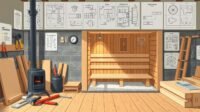Do you find it hard to get your Neptune water meter readings? Many people struggle to keep track of their water use. This can lead to surprise bills and wasted water.
Water meters can be tricky, with their digital screens and confusing numbers. But don’t worry, I’m here to help. I’ll show you how to read your Neptune water meter easily. This will help you control your water use, spot leaks, and maybe even cut down on your water bills.
Read also: 5 Easy Ways How to Take Lock Off Water Meter
Understanding Neptune Water Meter Types and Components
As a homeowner or water utility professional, knowing about Neptune water meters is key. Neptune has two main types: digital E-Coder meters and traditional Direct Read analog meters. Each type is made to give accurate water usage readings.
Digital E-Coder Meters
The Neptune E-Coder water meters are at the forefront of water measurement technology. They come with:
- Solar-powered digital LCD display
- Light-activated screen for easy reading
- Advanced data transmission capabilities
- High precision measurement technology
Direct Read Analog Meters
For older installations, Neptune’s Direct Read analog meters are a solid choice. These meters have a classic dial face. It makes it easy to read and track water usage manually.
Basic Meter Components
To learn how to read Neptune water meters, knowing their basic parts is important. Both digital and analog meters have similar key elements:
- Register (displaying total water usage)
- Measurement mechanism
- Flow indicator
- Protective casing
Understanding these meter types and components helps you better track and manage your water use.
Locating and Accessing Your Neptune Water Meter
Finding your Neptune water meter is key to understanding your water use. They are usually near the property line or inside your home. Knowing where to look can save you time and hassle.
- Near the street curb
- At the property line
- In underground meter pits
- Basement utility areas
- Crawl spaces
When looking for your meter, search for a protective cover or pit. Outdoor meters have removable lids. If you’re opening an outdoor meter pit, be careful:
- Wear protective gloves
- Check for insects or small animals
- Use a flashlight for better visibility
- Ensure the area is clear before opening
For indoor meters, check near your water main entry or in utility rooms. They should be easy to access for reading and maintenance. Knowing where your Neptune residential water meter is is important.
Pro tip: If you can’t find your meter, call your local water utility. They can help you find it based on your property’s layout and meter installation.
How to Read Neptune Water Meters
Reading your Neptune water meter is easy. Water companies use special systems to track how much water you use. I’ll show you how to read Neptune meter dials and understand the meter face.

Neptune water meters have different designs, but they all work the same way. Knowing how to read the meter is key to tracking your water use.
Reading the Digital Display
Digital E-Coder meters show clear, easy-to-read numbers. Here’s what you need to know:
- Readings show gallons with a decimal point
- The display is visible for 12 seconds
- Readings are usually rounded down for your bill
Understanding the Register Numbers
Register numbers show your total water use. Neptune meters are very accurate:
| Meter Type | Accuracy Range | Billing Increment |
|---|---|---|
| E-Coder Digital | 98.5% – 101.5% | 100 Gallons |
| Analog Meters | 95% – 101% | 100 Cubic Feet |
Interpreting the Flow Rate Display
The flow rate shows how much water you’re using right now. Neptune meters show flow rates in gallons per minute (gpm). For example, a flow rate of 50.7 gpm means you’re using water at that rate.
- The meter checks water flow every 15 minutes
- Continuous flow might mean a leak
- Leak indicators include a faucet icon (solid or flashing)
Learning these reading techniques will help you understand Neptune meter dials and your water use.
Activating and Reading E-Coder Digital Displays
Getting your Neptune E-Coder digital meter to show readings is easy. I’ll show you how to turn it on and read the info it shows. It’s all about waking up the display and understanding what it says.
To turn on the E-Coder display, you need to expose the solar panel to light. Here’s how to troubleshoot your Neptune meter:
- Direct sunlight works best for activation
- A bright flashlight can also trigger the display
- Wait for the initial segment test to complete
- Observe the manufacturing configuration screen
The display shows a sequence when it’s turned on:
- 20-second current reading screen (e.g., 179.21 gallons)
- 4-second flow rate screen (typically displayed in gallons per minute)
| Display Feature | Details |
|---|---|
| Reading Screen Duration | 20 seconds |
| Flow Rate Screen | 4 seconds |
| Typical Flow Rate Example | 50.7 gallons per minute |
Pro tip for accurate neptune meter readings: The device sends data every 14 seconds and updates every 15 minutes. This means you always have the latest info on your water use.
When you’re troubleshooting, watch out for the leak indicator. A solid faucet icon means a leak that lasts over 24 hours. A flashing icon shows an intermittent leak. If the last digit keeps going up when all water is off, you might have a leak that won’t stop.
Read also: How to Stop Brass Fittings from Leaking
Understanding Neptune T-10 Meter Face Components
The T-10 water meter is a key tool for tracking water use. Its face might seem complex, but I’ll explain its main parts. This will help you read it accurately.

The Neptune T-10 meter is made for precise installation and upkeep. It has three main parts that work together. They give you all the info you need about your water use:
- Register Section: Shows total water use
- Dial Section: Offers detailed reading precision
- Sweep Hand: Shows ongoing water flow
Navigating the Register Section
The register section looks like a digital odometer. It shows how much water you’ve used. Each number is a cubic foot of water. Watch the white and black numbers to track your water use accurately.
Exploring the Dial Section
The dial section is below the register. It gives you more detailed measurements. It’s like a clock face, with each segment showing a fraction of a cubic foot. This helps you track water use between billing cycles more precisely.
Understanding the Sweep Hand Function
The sweep hand shows your water flow in real-time. If it moves, water is flowing. If it doesn’t move, there’s no water use. Watching this hand helps you spot leaks or unusual water use.
Calculating Water Usage and Consumption
Reading your Neptune water meter is just the first step in understanding your water usage. I’ll guide you through how to figure out exactly how much water you’ve used in a certain time.
To find out your water usage, follow a simple method. First, record two meter readings at different times. Your initial and final readings. The difference between these numbers shows how much water you’ve used.
- For cubic feet meters, subtract the previous reading from the current reading
- Multiply the difference by 7.48 to convert cubic feet to gallons
- Check the meter’s lowest revolving dial to ensure accurate tracking
Let’s look at a practical example. If your Neptune water meter shows 278 cubic feet, here’s how to calculate usage:
- Previous reading: 250 cubic feet
- Current reading: 278 cubic feet
- Difference: 28 cubic feet
- Conversion: 28 × 7.48 = 209.44 gallons
Pro tip for accurate readings: Always watch the meter’s display type. Digital E-Coder meters show different info than analog meters. The neptune water meter reading guide suggests checking your meter model for exact calculations.
For the best water usage tracking, read your meter regularly and record the readings. This lets you see your usage patterns and spot any unexpected changes that might mean leaks.
Neptune Meter Leak Detection Features
Water conservation starts with understanding your Neptune meter’s leak detection capabilities. These advanced meters provide powerful tools to help you identify and monitor possible water leaks in your home.
Neptune water meters offer sophisticated leak detection features. These can save you money and prevent water waste. By understanding neptune meter troubleshooting tips, you can quickly identify and address water issues.
Decoding the Faucet Icon
The E-Coder digital meters have a special faucet icon. It acts as an early warning system for leaks. Here’s what you need to know:
- A solid faucet icon means a leak over 24 hours
- A flashing faucet icon means an intermittent leak
- The meter divides each day into 96 fifteen-minute intervals for precise leak detection
Interpreting Leak Indicators
For accurate neptune meter readings, pay attention to these key leak indicators:
- Continuous water use: Water detected in all 96 fifteen-minute intervals
- Intermittent leak: Water detected in 50-95 fifteen-minute intervals
- No leak: Water use in fewer than 50 intervals
Approximately 15-20% of water utility customers may have undetected leaks. By regularly checking your Neptune meter’s leak detection features, you can catch and address issues early. This saves water and prevents costly damage.
Meter Accuracy and Maintenance
Understanding Neptune residential water meters is key. It’s important to focus on accuracy and maintenance. This ensures your meter works well, helping you use water wisely.
Neptune meters meet high standards. The American Water Works Association (AWWA) sets strict accuracy rules. Neptune always meets these standards:
- Normal Flow Accuracy: 98.5% – 101.5%
- Minimum Low Flow Accuracy: 95% – 101%
- Ultrasonic Meter Low Flow Accuracy: 95% – 105%
Installing and maintaining Neptune meters is vital. Regular checks can spot problems early. This keeps your meter working right.
| Meter Type | Accuracy Range | Maintenance Frequency |
|---|---|---|
| Ultrasonic Meters | +/- 1% deviation | Annual inspection |
| Positive Displacement Meters | 95% – 101% | Bi-annual check |
Keeping your meter safe is essential. Make sure the area around it is clean. Avoid extreme temperatures and keep it free from blockages.
If your water readings change a lot, check with your local water company. They can help. Neptune meters usually last 10-15 years before needing a new one.
Conclusion
Learning to read Neptune water meters is more than a skill. It’s about knowing how much water you use and managing it well. In this guide, I showed you how to read both digital and analog water meters.
Your water meter is a key tool for tracking water use. Now, you can keep an eye on your water use and save money. You’ll also help save water by catching leaks early.
It’s important to check your water meter often. Water meters can lose accuracy over time. By keeping up with your meter, you’re helping to protect our water resources.
I hope this guide has made you feel more confident about your water meter. Every drop of water is important. Your new knowledge will help you use water more wisely.


